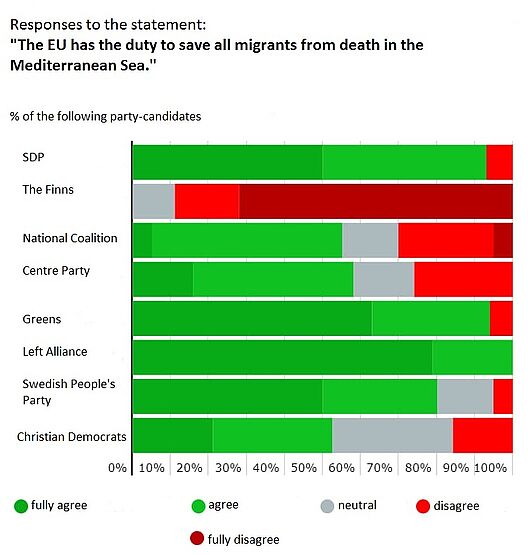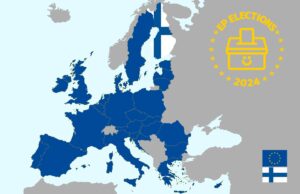Analysis by our member organisation “Vasemmistofoorumi” on the political landscape that shapes the European Elections in Finland.
Many national MPs appear as candidates for EU parliament. The candidate lists were registered on 18 April just four days after the national parliament elections and many who got elected to Finnish parliament search also place in EU-parliament. It remains, however, unclear if those MPs really will take a seat as MEP or are they just collecting votes for their parties. Those elected to both national parliament and EU-parliament can choose which seat they will take, and also return from EU-parliament to national parliament during the election period. The double candidacy is most visible among The Finns party which has six just elected MPs as candidates including the vice president of the party Laura Huhtasaari. Huhtasaari has announced that she will take a seat in EU-parliament if she will be elected.
In Left Alliance the current MEP Merja Kyllönen got elected to Finnish parliament and she is also candidate for EU parliament, although she has announced that because of personal family reasons she will not take the seat in EU parliament but will remain in Finnish parliament. Earlier she had expressed interest to continue in EU-parliament. Another Left Alliance MP, vice president of the party Hanna Sarkkinen is also candidate for MEP. Out of 20 candidates of Left Alliance 16 were candidates in national elections. One of them, and possibly the coming MEP, Silvia Modig from Helsinki failed to get to Finnish parliament where she had been MP since 2011 although Left Alliance got three seats (+1) from Helsinki. The Finnish election system requires voters to choose a candidate from a party list which emphasises the importance of personal election campaigns and the role of nationally well-known candidates. Among other parties also senior politicians who have ended their national political career are among leading candidates.
In the European elections in Finland, each party can present a maximum of 20 candidates, and all the parties try to maximise their number of votes by proposing the maximum number of candidates. The total of 269 candidates from 18 candidate lists (17 parties and one non-partisan candidate) is the record number of candidates in Finnish EU-elections. The Finnish election system is based on votes for candidates; it is not possible to vote only for a party but, instead, the voter has to select a candidate on a party’s list. This makes intra-party competition between candidates more intense than in countries with a fixed order of candidates on the party list.
The result of national parliamentary elections marked third national elections (2011, 2015, 2019) with a high level of support for radical right True Finns party, although its share of votes decreased slightly, the lowest result for Centre party for 100 years and the lowest result for centre-right National Coalition Party for 50 years, in terms of percent of votes. Social Democrats became the largest party but with the second worst result in the party history (the worst result was in 2015).
If the national election results will realise also in EU elections, SDP and The Finns will get three seats both (+1 for both of them), Coalition party three, Centre party two (-1), Greens one and Left Alliance one. However, the turnout will likely become significantly lower than in the national elections. In 1999 when national elections last time were held during the same spring as EU elections the turnout in EU elections was just 30,1%, significantly below the average of 40% in ordinary EU-elections. The low turnout has impact also on the support of political parties. Conservatives and Swedish-speaking population usually vote more actively and among Conservatives and Greens the interest to Europe is higher than among voters of other parties. This will mean that Swedish People’s party will get one seat as it has got in all elections to European parliament. Moreover, it is possible that among The Finns voters the interest to EU-elections is lower and they may get at best only two seats. The Centre party with many strong candidates from regions in Northern and Central Finland may also make a beter result than in national elections.
The negotiations to form the national government on the basis of centre-left-green coalition are going on during the election campaign and it is prognosed that the difficult issues in negotiation will be made public only after the EU elections. Anyhow, the political focus is now on government formation rather than European issues. The failure of conservatives and the Finns to be part of government coalition may result also in EU parliament elections with higher support for those parties.
In the 2014 elections, Left Alliance won a seat back in the European Parliament, which it had lost in 2009 by a small margin. It got 9.3% of the votes (compared with only 5.9% in 2009). Finland will have 14 members (one more than in 2014) in the European Parliament, and this means that a party needs approximately 6.0% of the votes for one seat. In 2014, Left Alliance’s most popular candidates were Merja Kyllönen, who was elected to the European Parliament with 58,611 votes, and Li Andersson, who at that time was not yet chairperson of Left Alliance and was not even a member of the Finnish Parliament, with 47,599 votes. Left Alliance candidates got 161,074 votes in total.
The result of Left Alliance in parliament elections was 8,2% of votes which would give one seat in EU parliament. The one seat is likely even if the support would be slightly lower than in national elections. A party will get one seat with approximately 6% of votes.
Interest in European elections is low. In 2014 and 2009, only around 40% of voters participated in the elections. This year, because of the proximity of the national elections, the turnout may be even lower, perhaps even lower than in 1999 when it was just 30,1%.
Voter advice application has been published by leading public and private media and they indicate important differences between parties. Among Left Alliance candidates all agree that the EU has duty to save all migrants from death in the Mediterranean Sea, while among The Finns candidates majority strongly disagree and no candidate agrees with this statement. Among Greens and Social Democrats almost all candidates agree and the same is true also with the majority of candidates of all traditional Centre Right parties.

Other question, if EU will disintegrate during next ten years, gets strong opposition among SDP and Green candidates, while majority of The Finns candidates agree with the statement.
According to a recent opinion poll, the most important topics in the European elections will be the economic situation in Finland, migration, the environment and nature protection, unemployment, and the economic situation in Europe. When compared with the state of affairs before the 2014 European elections, both migration and the environment are now significantly more important. Among Left Alliance voters, the most important topics are the environment (with 78% seeing it as important), unemployment (72%) and the increase in the cost of living (64%), while migration is not as important as it is among voters of all the other major parties.
Left Alliance is a pro-European party which emphasises that “the EU must be rebuilt to protect people and welfare societies against the tax haven economy and wage dumping”. It also believes that “power must be transferred from the European Commission to the European Parliament and the Parliament must be granted an independent right to take the initiative”. Moreover, Left Alliance demands that “The European Central Bank must be subjugated to democratic control by the Member States” (citations from Left Alliance Target Programme 2016-2019). Among Left Alliance voters, 67% see Finnish membership in the European Union in very or somewhat positive terms. The same result can be found among 66% of them with regard to Finnish membership of the euro. These figures are slightly lower than the national average (75-78% positive).
The minor left parties include the Communist Party of Finland (0.3% of votes in 2014) and the Communist Workers’ Party (which did not participate in order to protest against the EU). They are hard-line Eurosceptics and the electoral success of these parties will be insignificant.
Cover photo source: fb page of Vasemmistoliitto



